Visiting the Florida Gulf Coast Traditional Small Craft Festival
FISH Boatworks and Florida Maritime Museum at Cortez, FL
The historic fishing village of Cortez, FL is clinging tenaciously to its past even as other traditional Florida waterfront communities are irrevocably changed by modern development. Fishermen established the settlement in the 1880s and commercial fishing, particularly for mullet, has been a way of life ever since. Retiring the last of the fishing fleet and bulldozing the fish packing houses to create condominiums and dockominiums for retiring midwesterners and tourists might make more economic sense, but the old fishing families in Cortez might argue that their self-sufficient lifestyle and connection to the local environment have a unique value that is worth preserving.
Every April, the town is the site of a boatbuilders' gathering organized by the FL Gulf Coast Chapter of the Traditional Small Craft Association, at which a large and eclectic fleet of handmade craft and the people who make them gather to mess about in boats. Traditional boatbuilders are a bit like old Florida fishing villages: endangered by the modern world in which they have largely been replaced, yet persevering anyway. I decided to go up to check out the 2011 Great Florida Gulf Coast Small Craft Festival to see what it had to teach an aspiring boatbuilder like myself.
The Florida Gulf Coast Chapter of the Traditional Small Craft Association Festival was held at the site of the Florida Maritime Museum and the Florida Institute of Saltwater Heritage (F.I.S.H.) boatworks. The museum building is the old schoolhouse, restored and filled with model boats and ships and maritime memorabilia. They have also acquired the historic Burton Store, which survived the 1921 hurricane that devastated the rest of Cortez. It is sitting in the FISH Boatworks yard awaiting restoration.
I first stopped in the Maritime Museum to take a look at their exhibits. Out front, they have a traditional Cuban fishing vessel that was used by some Cubans to escape the Castro regime. Inside are pieces of other old boats, diorama models depicting traditional fishing life, and a number of nice wooden model boats. I was taking pictures of the models, including the catboat at left, and talking with one of the museum volunteers when one of my fellow catboat sailors, Paul, walked into the room. Paul signed the registration for the dinner that night, then we decided to walk on down to the docks and check out the boats.

On the way down the dock, we came across these people in the process of extracting their large dog from the cabin of their small sailboat. With the teenager lifting from behind and dad tugging from above, the dog managed to get out the companionway opening, but it was not pretty! Beautiful dog once on deck, but a good reminder for sailors to try to fall in love with smaller breeds.
The dock opposite the one we were on is an active commercial fishing dock with a packing house. The picture at left shows the current state of fishing technology: fast, shoal-draft boats that are capable of netting fish and setting crab traps in the shallow bays and backwaters. Commercial fishermen have come a long way from the days when net spreads for drying cotton nets and much more primitive boats dominated the shoreline.

When we got out to the floating docks where all the little boats were located, the first things we came across were some very nice paddling craft. This one has what appears to be a carbon fiber wishbone boom for the sailing rig. It is hard to see in the photo, but that leeboard on the other side of the boat is a real work of art. I think dragging it on the bottom would give me a heart attack.
The lapstrake rowboat with the flat bottom in the background of this picture was a really neat boat, but this strip built open kayak made me scarcely notice it! A boat like this seems far too attractive to risk using it around salt and sand.

A bit further out the dock were these two junk kayaks, and I'm not saying that to be mean! They were built as part of a competition to build kayaks out of waste building materials, if I understood correctly. They seem to have been made in skin and frame fashion, using whatever wood was around for the frame and Tyvec or groundcloth or something for the skin. That's boating on a budget! The black one looks pretty fast, too!
As we were examining the junk boats and the funny little boat beyond them, our fellow catboat sailor, Catboat Willy, came over from his boat to greet us, so I took a picture of Willy and Paul under the dock shelter.

The funny little boat at the end of the line was drawing a lot of attention, and someone asked whose boat it was.
"Moses," Paul volunteered.
That got a few chuckles, but the actual owner chimed in to explain that it is constructed with a ballistic nylon fabric skin, and the flat part is actually the bow of the boat. The number 13 is in the stern. That pretty much stopped the conversation, as no one really knew how to react to this boat.
A while later, I saw someone attempting to recreate Moses' journey. He appeared to by trying to scull in the direction we had been told was "forward," but was not having much success and the wind and tide were taking him sideways toward that narrow creek opening.

The largest boat to attend the Traditional Small Craft Festival was this gaff-rigged cutter named Surprise, which appears to be built on an old fishing boat design. I guess they stripped the sails off for show, but I do wonder about that monster outboard motor bracket. It looks sturdy enough to take an engine in the 20-30 hp range, big enough to drive the boat. Does that boat really have no inboard power? It looks like a shoal draft design, so I guess they might just put a 25 hp on there to drive the boat. It would not be fun wrestling such a heavy engine on and off the bracket by hand, but it looks like the mainsheet could easily be used for that purpose.
The other "big boat" at the small boat gathering was the catboat Nadine, which is not exactly a traditional catboat, but is a very nice looking cruiser all the same. She has a LOT of cabin and not all that much sail area for a catboat. Aft of Nadine is an old fashioned power launch with glossy black topsides.

Here is a shot of the black launch a bit later, when they were departing. If you're going to have a powerboat at a traditional craft festival, this is certainly a good choice! What may appear at first glance to be a death grip on both rails by the passenger was really more of a relaxed sprawl. The boat is just narrow enough to comfortably reach both sides.
Up in the parking lot, we encountered another powerboat entrant: this outboard powered traditional strip built skiff. I'm not sure what to think of that. I like outboards on small boats and dislike tiny little inboards in tiny little spaces, but that just looks wrong. It kind of looks like someone took a chainsaw to a really nice rowboat and stuck in an outboard.
I suppose if you are driving it, you do not see the outboard and you do not have to row. It does have a certain charm, but I can't get over how ridiculous the engine looks.

Back out on the dock, Willy's catboat Sea Bird is tied up next to another small power launch. This one has a little air-cooled engine in that box, which sounds like a bad enough idea to send me running for a chainsaw and an outboard. Now I think I understand how the boat above came to be outboard powered...
I caught a picture of the little launch as it was leaving with a very nice wooden decked kayak in tow. It sounded like an old VW Bug engine as it went putt putting away.

I walked out onto the sand bar to take a closer look at some of the boats scattered around in the knee-deep water. Being a multihull enthusiast, one that caught my eye right away was Shark Bait, a kayak trimaran with a ketch rig. It looks very light and can obviously carry quite a bit of sail for such a little boat. I was hoping to get the opportunity to see it sail, and after a while, I did, but only from a distance.
I do not know how it got away without my noticing, but here is a picture of Shark Bait under sail. It looks like the sail has zippered panels to reduce sail area and the mainsail is missing one. The jib is completely furled. The wind was not all that strong, so the reduced sail area suggests a light air flyer to me. I would love to take it for a ride! That's a big flag hanging off that sail, though. I think a smaller one would be just as patriotic and much better looking.

One of my favorites as I wandered the flat was this gaff-rigged schooner strip built canoe. It straddles the line between cute toy and real boat nicely, and the workmanship was excellent. I would rather sail Shark Bait, but this one is nice to look at!
There were many wooden boats finished bright, which is always a more attractive look to me than a painted boat, but this one really stood out. I think that is a mahogany deck on this Melonseed, and the rich, red color goes nicely with the tanbark sail. By far the nicest finish job I saw at the festival. If I owned such a beautiful boat, I would lock it in a nitrogen-filled storage room. It's just too pretty to expose to the Florida environment. Or maybe I would just paint it and use it, but I don't think I could use it if it looked like that. What if I scuffed it or something??

I met the proud owner of this little lapstrake skiff called Rascal when I was standing out by the boats. I commented that his engine seemed a bit big for the boat, and he told me that she sails and rows nicely, and that 5 hp two stroke engine will actually make the boat plane with a light load! OK, so maybe it's worth it to carry the larger engine around, if you're going to have one aboard at all. It is not traditional, but significantly changes the capabilities of the boat. Places that are out of range at slow speed are suddenly not so far if you are in a planing skiff.
In the background of this picture, you can see the beautiful Melonseed from the above photo attempting to leave under sail. They kind of got blown into the pilings over there, and were having a bit of trouble getting out. You can also see a little green catboat sailing in the channel.
The little green catboat is named Mar, and aboard were an old salt who seemed to know how to handle a dinghy and a young girl who seemed a bit terrified by the whole thing. They were moving right along downwind, then picked up some speed turning up toward the flat where I was standing. The young girl yelled, "We're going to crash!" About that time, the skipper turned the rest of the way into the wind to stop the boat and I grabbed the bow, though it was not really necessary. An expert landing, I was just being polite. The girl seemed astonished and pleased that the boat and dock were not a joined mass of splinters.

I was walking around in the water when this lady paddled by in this really gorgeous wood kayak. That light wood used for the deck really had a nice glow to it that does not come through in the picture. This is the same little kayak that was being towed by the black motor launch in a photo above.
I believe the moored boat is a Core Sound 17, and since I am very interested in that boat's big sister, the Everglades Challenge 22, I wanted to take a closer look, but it was out kind of far in deeper water. I did not want to that badly, I guess! I got close enough to take this picture as a Melonseed sailor went by, then turned back toward the dock.

The Lighthouse Archaeological Maritime Program (LAMP) Boatworks is a traditional wooden boatbuilding program up in St. Augustine, FL, and the LAMP volunteers brought their skiff down to the festival this year.
Though a bit plain to the eye, this was one of my favorite boats at the festival. It just looks very practical, capacious, and well thought-out for a boat of this size. It also looks like it would not require a nitrogen filled storage facility.
I would not mind a bit using it and scratching it up. It looks easy to fix, and a fix on one of these is a lot easier to hide than on one of the gorgeous wooden boats.
I found a short video of this boat, or one just like it, under sail:
Next to the boat from LAMP Boatworks was this little catboat. I like the cockpit grate and the wide side decks, but it needs oarlocks and a place to use them. It is about the size of the LAMP boat, but looking at the two of them, I would rather sail the LAMP boat with a couple of friends, the catboat by myself. That's a big mast, and while I never saw the whole sail, it must be pretty large judging by the boom and sprit laying in the cockpit.

Sallie Adams was the biggest boat out on the flat. She's a Cortez boat, so the ability to get around on these shallows is important. Out beyond Sallie Adams is a kind of boxy looking microcruiser. I think that one is even smaller than the SCAMP, which is my favorite entrant in the "smallest is best" cruiser department.
Displaying her own shoal draft capability, this Americraft catboat has a businesslike appearance. I like the tanbark sail and simple Marconi rig, but the sail looks a bit small to my eye for a catboat. Many carry a gaff sail that overhangs the transom, with quite a bit more sail area. It looks fun and easy to sail, though, and if it is not too heavy should perform OK in all but the lightest winds.

Some fellow multihull sailors brought a couple of ultralight trimarans. One of these has a Marconi cat rig with a roller furling mast, while the other has a fractional sloop rig with roller furling jib. It is hard to tell, but it looks to me like that mainsail rolls around the boom when not in use on the sloop rig, which looks considerably more powerful. The boats are not very different in size, almost twins it seems, but the rigs are very different.
As I was getting ready to leave later on, I saw the trimarans disassembled and loaded on their custom trailer. Lots of parts and pieces!

We decided to walk up to the parking lot restaurant to get some food, and along the way I saw these fishing boats jockeying for dock space across the canal. The skiff in the foreground has trim tabs, and I was wondering...
...ummm...guys? The fishing skiff? In the foreground? There are fishing boats in that picture. And an S2 sailboat... Nevermind. Moving along...
OK, in this picture that contains no distractions, you can see that the fishing skiff has trim tabs on the transom. I was wondering where the controls are? Usually, trim tab controls are on the console near the throttle and steering wheel, but that is a tiller steered boat with no visible console. I guess they just hang them on the side of the seat or something.

Up in the parking lot, they had this replica of a Spanish scout/raider ship of the type that people like DeSoto would have used in the exploration and colonization of Florida. The shallow waters and strong currents in inlets along the west coast of Florida would have been hazardous for an old square-rigger, so the solution to approach a new shore was a small boat with six rowing stations. The cannon had to do with what to do when you get there...
I guess a scout/raider should have a gun, but I have to wonder whether something like this could really present a danger to anyone besides those aboard? It does not look powerful enough to damage a ship, nor accurate enough to hit a small boat. I guess it would make a heck of an impressive BANG!

One last shot in the water- this one of a classic rumrunner style runabout, but a bit modernized and with four stroke outboard power instead of the conventional inboard. The finish on this boat was outstanding. I thought the matching shirts made the whole thing a bit too attractive to be in the water, but I seem to have that opinion about a lot of good looking boats.
At the other end of the boat appearance and condition spectrum, this neglected ketch sat in the parking lot with a condemnation sticker on the side, or what was left of the side. You can see a crack that is several feet long on this side, and the rest of the boat was not in much better condition. It appears destined for a date with a chainsaw. Boats in this condition always make me wonder: on the day they launched this boat, did anyone imagine it would come to this end?

The sign pointing the way from the museum parking lot out to the FISH Boatworks area is an old boat, very appropriate. This one looks too far gone to ever make the restoration list, but it makes a great sign. On the way back to the boat building area, I saw the old Burton Store sitting in the field awaiting restoration. It looks like a pretty ordinary Florida Cracker Shack, but a bit larger and older than most.
There were several project boats in various states of ruin and restoration around the yard, but the showpiece at the moment was clearly this wooden Bahamas cruiser that is being restored under a tarp in the yard. I recall someone saying it is 28 feet long. It has quite a large pilothouse for a boat this size and a good sized cockpit. I wanted to get up and look inside, but no one was around.

Also under restoration at FISH was this long canoe, or possibly it is a kayak. The hull shape looks a lot like the native dugout canoes on display in the museum, but it is not a dugout. Whatever it may be, any boat that long and skinny is going to be fast to paddle!
I do not know what this boat is, but my first reaction to it was "Incredible Hulk." The bilge underneath the engine compartment was rotting out, among other things, but I guess someone has in mind restoring the boat.
I left the Traditional Small Craft Festival feeling a bit overwhelmed. I wanted to see a slice of what people out there are building to get some ideas and came away with more than I expected. Subsequent research about the boats I saw has led to many more boats, and at this point they all seem to highlight something else about boat building that I do not know. I'm guessing another year or so of this might be enough to teach me all of the things I do not know, at which point I can start learning some of them! Maybe it will not take so long...
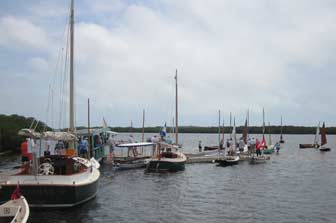
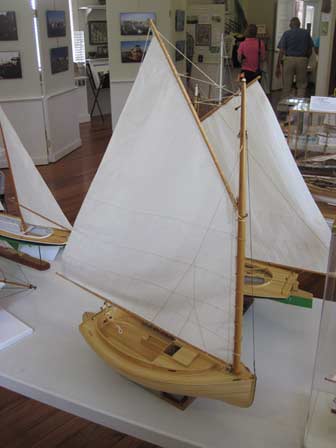
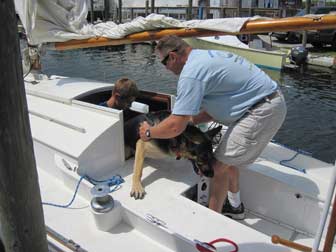
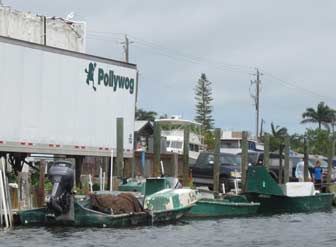
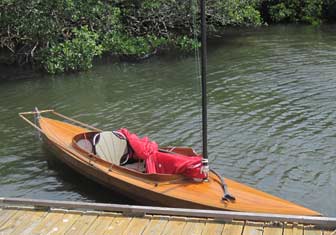
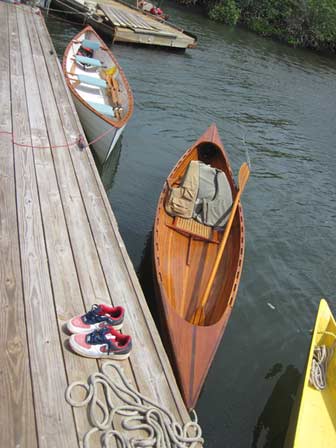
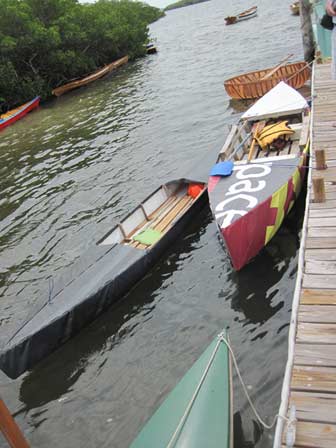
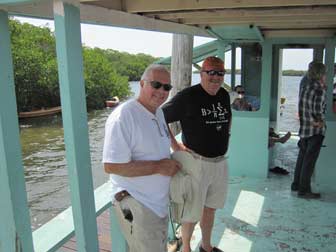
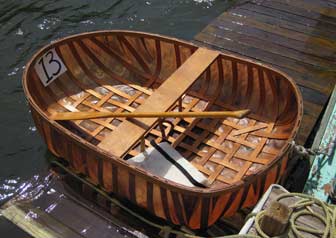
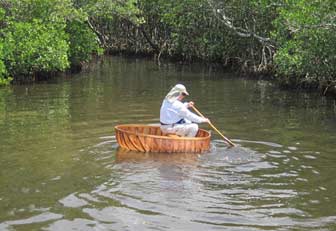
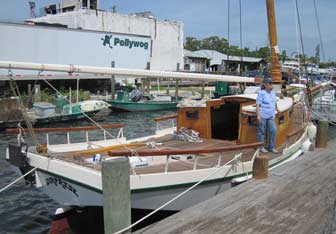
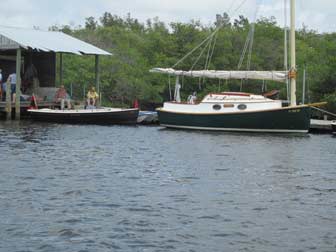
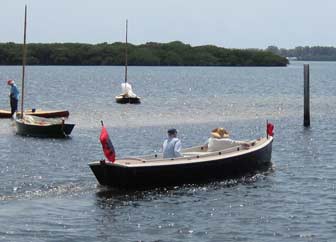
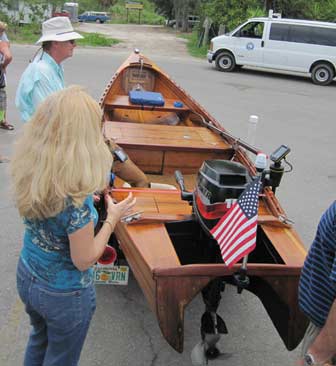
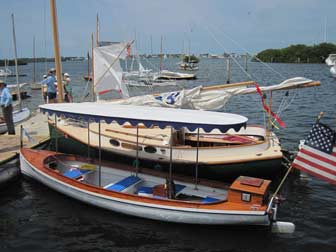
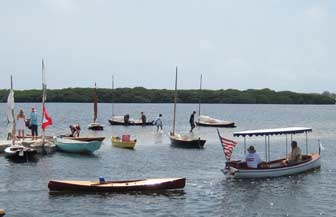
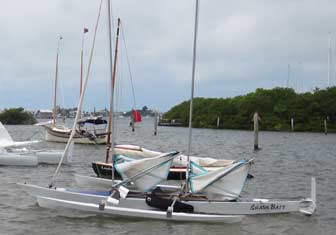
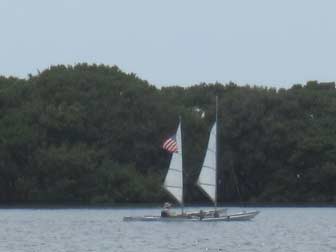
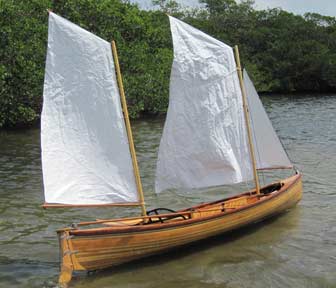
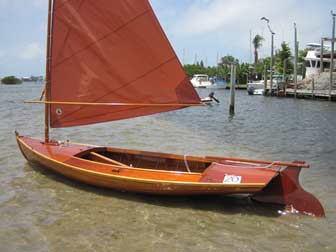
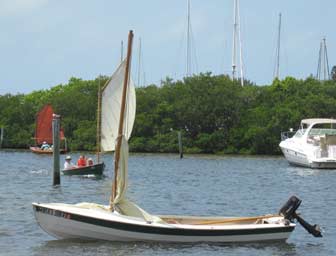
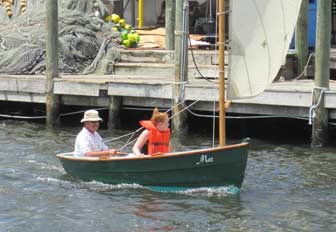
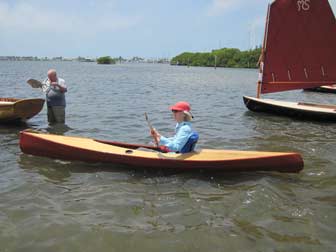
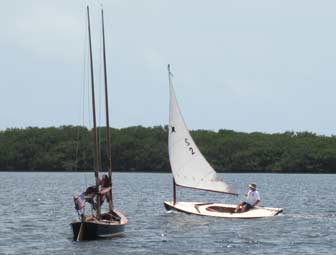
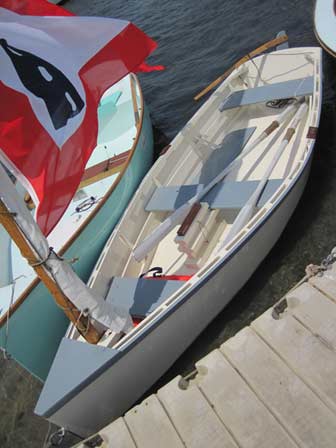
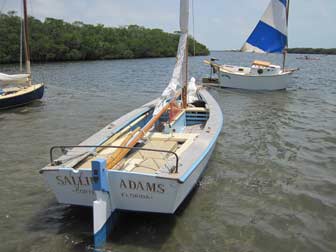
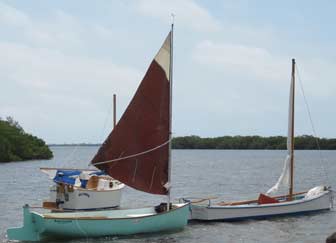
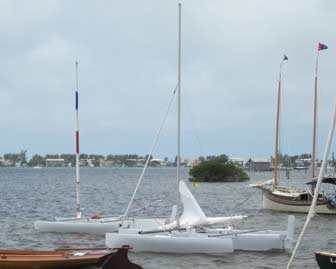
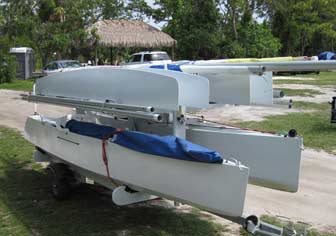
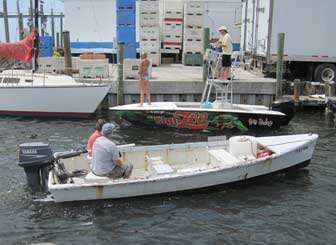
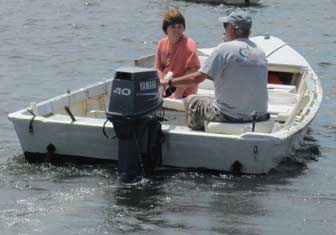
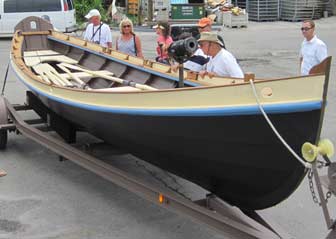
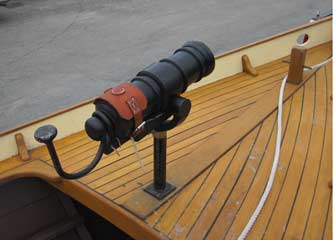
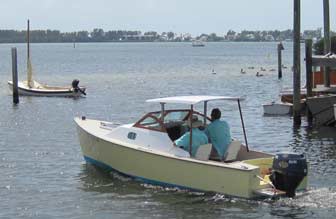
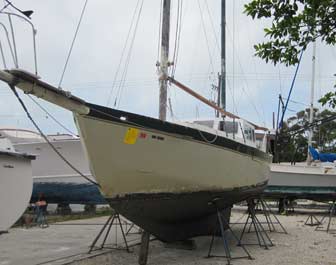
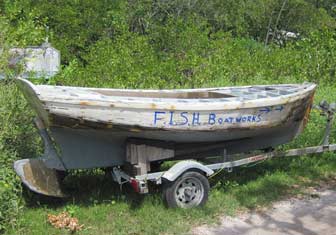
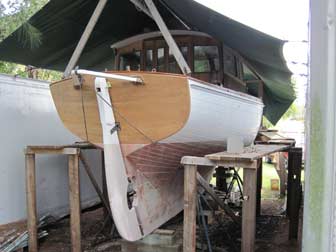
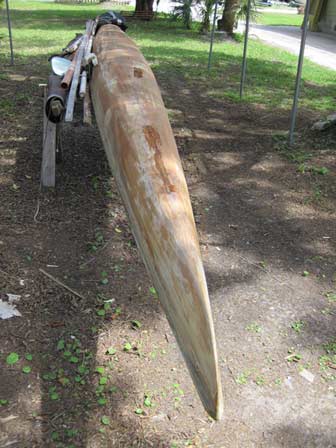
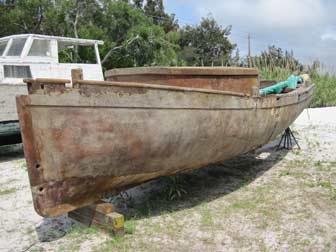
Leave a Reply
You must be logged in to post a comment.